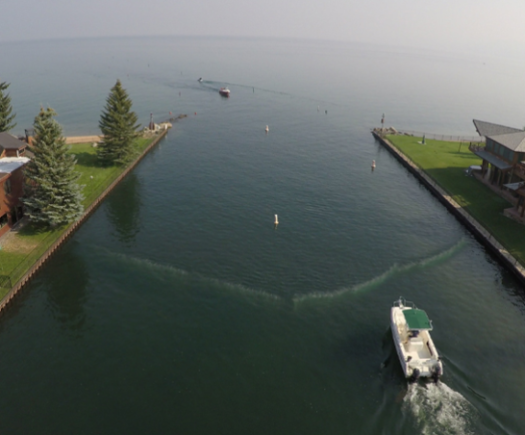Control of Debris
An Innovative Solution to Prevent Plastic from Reaching the Oceans
Bubble Curtain – Anti-Plastic Barrier
One effective method of controlling the flow of plastic waste and debris is to capture it from rivers and canals before it can end up at sea, where it is much more difficult if not nearly impossible to capture effectively.
The exclusive bubble barrier, developed by the engineers of Bubble Tubing®, greatly facilitates the interception of plastic, including its fine particles as small as 2 mm in all rivers around the world. Several eco-responsible organizations that care about the health of the environment are showing great interest in this innovative technology and we are proud to assist them in achieving their goals.
How Does this Technology Deflect Plastic to the Banks?
The principle is as simple as it is ingenious. Just imagine a river and its current as a source of energy. This energy, which forms, deforms and meanders over the centuries and carries enormous amounts of sediment, also displaces debris, waste and for less than a hundred years, plastic. Plastic is peculiar when it has just been found in water. It will float and after a few days, it becomes covered with biofilm, bacteria and dirt, it then finds itself between two waters, like in suspension. After several weeks, this same plastic eventually becomes heavier and ends up at the bottom of the river where it rolls with the current towards the river mouths. A diagonal bubble curtain does not claim to block plastics but simply deflect them towards the bank. The bubbles rising to the surface also create a vertical current. A bubble curtain will work and induce effective deflection if its angle is adjusted according to the velocity of the average current and the air flow of the bubble curtain. The size of the bubbles will also influence the minimum size of microplastics that can be redirected effectively. Plastics in suspension or those that roll on the bottom of a river can also be moved by the bubbles to a collection point on the bank.
How is the Bubble Curtain Unique in Controlling Plastic?
The versatile bubble curtains from Bubble Tubing® do not prevent boat traffic or marine life of all sizes from passing through the bubble wall. Some customers using our technology have achieved efficiency levels exceeding 86% collection and deflection (Numbers supplied by The Great Bubble Barrier® pilot project).
The Bubble Curtain Promotes the Management of Plastics
Closely monitoring the evolution of waste that passes through a stream after having gathered it in a predetermined circumscribed area with the help of a Bubble Tubing® curtain is achievable.
Bubble Tubing® bubble curtains allow authorities to identify and measure the different types of waste, their origins and thus obtain precise tools allowing better management of upstream actions in the watersheds. Several large world cities are committed to the environment and they can use the bubble curtain as a management tool allowing the effective measurement of actions taken in the different regions affecting the major rivers of the world. Ultimately, stakeholders concerned with the health of the oceans and rivers have more data and predictions that facilitate their decision-making.
Bubble Tubing® is recognized as the world leader in the design and manufacture of multifaceted bubble curtains. Our company is proud to partner with other organizations that are proactive in tackling plastic pollution in the world’s oceans.
Who is the Debris Control Application for?
The retention of plastics occurs in waterways before they reach the oceans. Governments, public bodies and private companies contribute to water purification with the installation of a complete retention and recovery system for floating and submerged debris in water.



The retention of plastics occurs in waterways before they reach the oceans. Governments, public bodies and private companies contribute to water purification with the installation of a complete retention and recovery system for floating and submerged debris in water.


